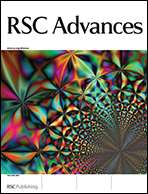Design, synthesis, characterisation and in vitro studies of hydrophilic, colloidally stable, 64Cu(ii)-labelled, ultra-small iron oxide nanoparticles in a range of human cell lines†
Abstract
The application of ultra-small super-paramagnetic iron oxide nanoparticles (USPIONs) as versatile diagnostic probes for multimodal imaging in biomedicine, including via magnetic resonance imaging (MRI) and positron emission tomography (PET), requires hydrophilic and biocompatible surface coatings. Herein, we describe the development of USPIONs stabilised by octylamine-modified polyacrylic acid (OPA) and the subsequent conjugation of a 64Cu(II) chelator, N-(4-aminophenyl)-2-[4,7-bis(2-pyridylmethyl)-1,4,7-triazacyclononan-1-yl]acetamide (amino-dmptacn), for radioactivity-based detection. Transmission electron microscopic analysis and dynamic light scattering measurements confirmed the monodispersity and stability of the OPA-USPIONs in aqueous media and revealed a hydrodynamic size of ca. 15 nm. Furthermore, the biocompatibility and cellular uptake efficiency of the functionalised USPIONs was investigated in a range of normal and tumour cell lines. The results clearly show a cell type- as well as time-dependent internalisation of the OPA-USPIONs via active energy-dependent pathways. Biocompatibility of OPA-USPIONs in the concentration range of 10–50 μg mL−1 was demonstrated, while impairment of cellular viability was observed for human umbilical vein endothelial cells at 100 μg mL−1. Upon exposure to human serum, several biomolecules cover the negatively-charged surface of the nanoparticles and a biomolecular corona is formed. Nonetheless, the nanoparticles represent a promising platform for the future development of a bimodal PET-MRI tumour-imaging agent.


 Please wait while we load your content...
Please wait while we load your content...